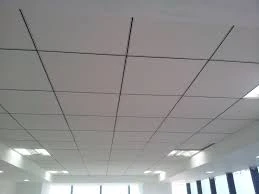Dec . 27, 2024 06:04 Back to list
ceiling grid insulation
Understanding Ceiling Grid Insulation A Comprehensive Guide
In the domain of construction and interior design, ceiling grid insulation has emerged as a critical component in creating comfortable, energy-efficient spaces. Whether you're considering renovations for a commercial space or enhancing a residential area, understanding the intricacies of ceiling grid insulation can significantly impact the overall efficacy of your design. This article delves into the concept of ceiling grid insulation, its benefits, materials used, and installation considerations.
What is Ceiling Grid Insulation?
Ceiling grid insulation refers to the insulating material that is used in conjunction with suspended ceiling grids. Suspended ceilings, also known as drop ceilings, consist of a grid system that holds tiles, often made of acoustic materials. This grid structure is not only functional in supporting the ceiling tiles but also plays a vital role in thermal and acoustic insulation.
The primary purpose of ceiling grid insulation is to improve the thermal efficiency of a building. By reducing the heat transfer between the occupied spaces below and the attic or unconditioned space above, insulation can significantly lower energy costs and improve overall comfort. Moreover, acoustic insulation helps in soundproofing, making it especially important in environments where noise reduction is a priority, such as offices, schools, and hospitals.
Benefits of Ceiling Grid Insulation
1. Energy Efficiency One of the most compelling reasons to invest in ceiling grid insulation is its ability to enhance energy efficiency. Proper insulation helps maintain desired indoor temperatures, reducing the need for excessive heating or cooling. This translates into lower energy bills and a smaller carbon footprint.
2. Sound Absorption Acoustic insulation integrated with ceiling grids can help absorb sound, minimizing echo and external noise. This is crucial in settings that require quietness for concentration and productivity, such as libraries or conference rooms.
3. Moisture Control Many insulation materials also provide moisture control, preventing condensation and potential mold growth in ceiling spaces. This is particularly important in humid climates or areas prone to water leaks.
4. Aesthetic Flexibility Suspended ceilings with insulation options come in various designs, colors, and textures, allowing homeowners and designers to maintain aesthetic flexibility while ensuring thermal and acoustic performance.
5. Fire Resistance Many insulation materials are designed to be fire-resistant, contributing to overall building safety. This feature is especially important in commercial buildings where safety regulations must be strictly adhered to.
Common Materials Used in Ceiling Grid Insulation
When it comes to ceiling grid insulation, several materials are commonly used
ceiling grid insulation

- Fiberglass Fiberglass insulation is one of the most widely used materials. It offers excellent thermal performance and sound absorption. It is typically available in batts or rolls, making it easy to install within ceiling grids.
- Mineral Wool Known for its superior fire resistance, mineral wool insulation also provides excellent acoustic properties. It is often utilized in commercial settings where safety and sound control are paramount.
- Foam Board Insulation This rigid insulation material can also be used in conjunction with ceiling grids, offering high insulating values per inch of thickness. Foam board is particularly useful in areas requiring a higher R-value.
- Acoustic Ceiling Tiles These are often designed specifically to work with suspended ceiling grids, providing both sound absorption and aesthetic appeal.
Installation Considerations
Installing ceiling grid insulation requires careful planning and execution
1. Evaluate the Space Before installation, assess the space for its specific insulation needs. Consider factors such as climate, desired R-value, and acoustic requirements.
2. Select Appropriate Materials Choose insulation materials that align with your objectives. Ensure they are compatible with the existing ceiling grid structure.
3. Ensure Proper Installation It’s essential to follow manufacturer guidelines during installation to achieve optimal performance. Sealing joints and perimeter gaps is crucial to prevent energy loss.
4. Consider Professional Help Depending on the complexity of the project, it may be wise to seek professional assistance. Experienced installers can ensure that the insulation is installed correctly and efficiently.
Conclusion
Investing in ceiling grid insulation offers numerous benefits, from enhanced energy efficiency and sound absorption to aesthetic appeal and safety. By understanding the materials and installation practices, homeowners, builders, and designers can create comfortable, efficient environments that meet contemporary standards. Whether for residential or commercial applications, ceiling grid insulation is an essential element that contributes significantly to the overall quality of the built environment.
-
Quality Ceiling Trap Doors & Access Panels | Easy & Secure AccessNewsAug.30,2025
-
Durable Ceiling T Grid Systems | Easy InstallationNewsAug.29,2025
-
PVC Gypsum Ceiling: Durable, Laminated Tiles for Modern SpacesNewsAug.28,2025
-
Pvc Gypsum Ceiling Is DurableNewsAug.21,2025
-
Mineral Fiber Board Is DurableNewsAug.21,2025
-
Ceiling Tile Clip Reusable DesignNewsAug.21,2025







